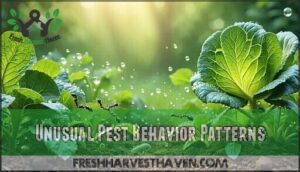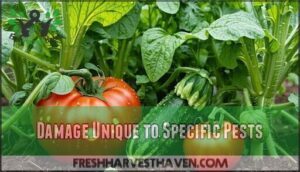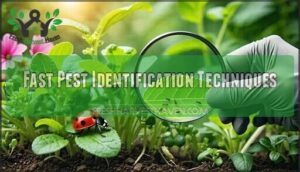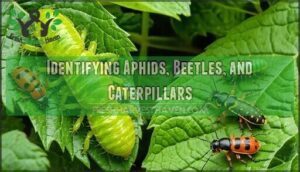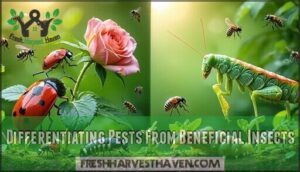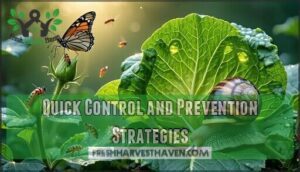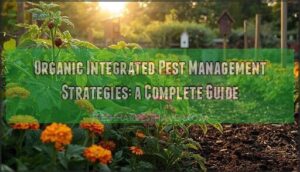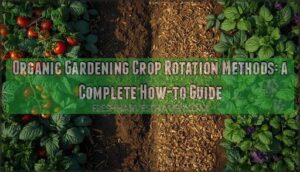This site is supported by our readers. We may earn a commission, at no cost to you, if you purchase through links.

Shiny trails point to slugs or snails, while tunnels in roots spell trouble from underground pests.
A sharp eye, a quick check for egg masses or odd webbing, and even a sticky trap or two can help you get ahead. The real secret? Knowing which pest left its mark.
Table Of Contents
- Key Takeaways
- Key Signs of Common Garden Pests
- Fast Pest Identification Techniques
- Top Insect and Non-Insect Garden Pests
- Differentiating Pests From Beneficial Insects
- Quick Control and Prevention Strategies
- Frequently Asked Questions (FAQs)
- How to identify common garden pests?
- How do I identify what’s eating my plants?
- What is the hardest plant pest to get rid of?
- How can I identify a pest?
- When should I apply preventive pest treatments?
- How do weather conditions affect pest activity?
- Which plants naturally repel common garden pests?
- Can beneficial insects harm my garden plants?
- How often should I replace sticky traps?
- Can pests develop resistance to natural remedies?
- Conclusion
Key Takeaways
- Check leaves and stems daily for holes, sticky residue, and odd patterns—they’re pest warning signs. – Match damage—like curling, spots, or shiny trails—to specific pests so you react fast and don’t guess. – Use sticky traps and mobile ID apps to quickly confirm what’s invading your garden. – Encourage good bugs and avoid misidentifying them as pests by knowing their unique features.
Key Signs of Common Garden Pests
You’ll spot common garden pests by checking for holes in leaves, curling stems, and sticky residue.
Look for damage patterns that help you tell pests apart so you can act quickly and protect your plants.
Visual Clues on Leaves and Stems
Pay close attention to your plant’s leaves and stems—they’ll tip you off if something’s wrong.
Notice any weird colors on the leaves or odd-looking damage to the stems? Those are early warning signs of garden pests.
Frass identification—those telltale droppings—is a dead giveaway for insect pests. Look for honeydew presence, especially with aphids.
Check carefully for egg mass location and signs of Leafminer trails. Master these basics, spot trouble early.
Unusual Pest Behavior Patterns
Watch for odd migration patterns like insects suddenly swarming new plants or ants following precise trails—these signal Pest Communication at work. Shifts in feeding habits—like chunks missing overnight—hint at nocturnal activity.
Some pests blend in using camouflage tactics, making identification tricky. Spotting trails of honeydew or subtle shifting patterns is key to quickly identifying garden pests during infestation.
Damage Unique to Specific Pests
Anybody can spot odd leaf holes, curling stems, or fruit scars in the garden. Pest feeding patterns leave clues—aphids cause curling leaves, while beetles chew jagged edges.
Some insect pests tunnel into roots, stunting growth or spreading plant diseases. Fruit deformation often signals boring insects.
Use an insect identification guide to match leaf damage types and pinpoint garden pests faster.
Fast Pest Identification Techniques
You can identify garden pests quickly using visual checks, simple mobile tools, or sticky traps.
By using these tricks, you’ll catch and deal with pests early—long before they can cause real trouble in your garden.
Visual Inspection Tips
Spotting garden pests often starts with using your eyes and a little detective work. After you notice holes or curling leaves, check for:
- Leaf Spot Analysis: Look for unusual patterns or dark spots. – Pest Egg Detection: Scan leaf undersides for clusters. – Early Infestation Signs: Sticky honeydew or webbing means trouble.
Sharp observation brings answers fast.
Using Mobile Apps and Online Tools
After checking for signs, let technology lend a hand in identifying common garden pests. Use apps with excellent App Identification Accuracy and Image Recognition Software, backed by reliable Pest Database Reliability. Expert System Integration and Citizen Science Platforms boost Garden Pest Management. These apps often foster eco-friendly gardening practices through targeted interventions. Quick results help you tackle insect pests and plant disease identification faster, without guessing.
| Feature | Benefit |
|---|---|
| App Accuracy | Reliable IDs |
| Image Recognition | Fast Pest Spotting |
| Database Reliability | Trusted Details |
| Citizen Science Support | Expand Knowledge |
Setting Up Sticky Traps
Setting up sticky traps boosts your garden pest management skills. Want to catch insect pests and spot trouble early? Do this:
- Trap Placement: Hang traps near vegetable garden pests.
- Color Matters: Yellow attracts many identifying common garden pests.
- Trap Maintenance: Replace when filled.
- Target Pests: Customize for specific bugs.
DIY traps help with pest control and quick identification.
Top Insect and Non-Insect Garden Pests
You’ll find both insects and non-insects causing problems in your garden, each with unique signs of damage.
Learn to identify these pests quickly so you can control them before they cause lasting harm.
Identifying Aphids, Beetles, and Caterpillars
Early mornings in the garden are best for Aphid Identification, Beetle Varieties, and Caterpillar Stages. You’ll find aphids clustered under young leaves, while beetles often hide by day and eat at night. Caterpillars leave ragged edges behind. Note that chewing mouthparts on pests like caterpillars cause significant damage to leaves and stems.
Here’s a quick reference table to help you spot the difference between common garden pests and their lookalikes when you’re checking for leaf and stem damage:
| Pest | Color |
|---|---|
| Aphids | Green |
| Beetles | Various |
| Caterpillars | Green |
| Pest Lookalike | Brown |
| Damage Assessment | Ragged |
Spotting Mollusks and Arachnids
From shady corners to damp mulch, slugs and snails make themselves at home by leaving shiny trails and ragged holes—a clear sign of Snail Damage. For Slug Identification, hunt early mornings.
When webs coat leaves, check for Spider Mites, not Garden Spiders. Both thrive in different Arachnid Habitats, so knowing these Common Garden Pests saves crops fast.
Recognizing Indoor and Outdoor Invaders
Now that you’ve spotted garden mollusks and crawlers, it’s wise to look closer at indoor pests. Watch Pest Entry Points like cracks in doors or vents.
Identifying Damage Type helps you catch seasonal pest variations, especially with invasive species. Learn pest life cycles.
Indoor and outdoor invaders, like aphids or ants, challenge gardening and controlling garden pests year-round.
Differentiating Pests From Beneficial Insects
You need to tell pests apart from helpful insects so you don’t harm the ones that protect your plants.
Understanding common traits and behaviors lets you make quick, accurate decisions in your garden.
Common Good Bugs to Encourage
Now that you know garden pests, let’s talk helpers. Attracting Ladybugs, Parasitic Wasps, and Green Lacewings boosts your garden ecosystem and keeps pests in check. Beneficial insects like these are easy to spot and nurture if you offer:
- Native flowers
- Varied plant heights
- Shallow water dishes
- Shelter from wind
Let your good bugs flourish.
How to Avoid Mistaken Identity
Many bugs in the garden are experts at hiding in plain sight—some are pests, while others are actually helpful. Before taking action, slow down and double check: is it really a pest, or could it be a look-alike at a different life stage?
Misreading the signs can lead to overreacting, so try not to rush. Reference the table below when you’re unsure, and don’t hesitate to reach out to an expert if things aren’t clear.
Spotting the small details is key—think specifics, not just general traits.
| Insect/Sign | Likely Identity | Watch For |
|---|---|---|
| Clustered Aphids | True Pests | Curling leaves |
| Ladybugs | Beneficial | Black spots, dome shape |
| Lacewing Larvae | Beneficial | Alligator shape |
| Beetle Nymphs | Pest Look-alikes | Color and movement |
| Damage Patterns | Damage Misdiagnosis | Severity, false positives |
Signs of a Healthy Garden Ecosystem
If you’ve ever wondered if your backyard’s buzzing for the right reasons, keep an eye out for these signs. A healthy patch means balanced predator-prey action, thriving plant growth, and a good mix of pollinators and beneficial insects. Think of these points:
- Diverse insects, including pollinators
- Natural pest control in action
- Flourishing plant health
- Visible soil biodiversity
- Minimal signs of plant diseases
Quick Control and Prevention Strategies
You can stop the most common garden pests by acting quickly and using a mix of control strategies.
Learn how to combine organic treatments, practical prevention methods, and basic pest management to keep your plants healthy.
Immediate Organic Solutions
Your garden’s first line of defense calls for smart, immediate organic solutions. Grab neem oil for soft-bodied pests, use insecticidal soap on delicate leaves, sprinkle diatomaceous earth for crawling invaders, and practice companion planting to deter troublemakers. Daily manual removal works wonders, too. Identify and act fast—pest control is easier when you start early.
| Solution | Targets | Note |
|---|---|---|
| Neem Oil | Aphids, beetles | Safe for beneficials |
| Insecticidal Soap | Mites, whiteflies | Use weekly |
| Diatomaceous Earth | Crawling insects | Avoid wet areas |
| Manual Removal | All pests | Check daily |
Biological and Mechanical Controls
Use Beneficial Insects like ladybugs for pest control—think of them as your cleanup crew. Pest barriers such as row covers help keep invaders out. Try handpicking pests for quick results.
Focus on soil health and companion planting to foster crop protection.
Non-Insect pest control keeps pests in check, forming a strong base for agricultural pest management.
Integrated Pest Management Essentials
A winning defense starts with Integrated Pest Management Essentials. You’ll lean on IPM Principles to combine Biological Controls, Cultural Practices, and smart Monitoring Techniques. Spot trouble early, intervene only when needed, and use Chemical Controls as a last resort. This way, you’ll protect crops, identify issues fast, and tackle Plant Diseases before they escalate.
- Monitor pests regularly
- Rotate crops for resilience
- Attract beneficial insects
- Apply chemicals thoughtfully
Frequently Asked Questions (FAQs)
How to identify common garden pests?
Spot common garden pests by their habits and appearances. Aphids cluster on stems and leaves, while cabbageworms chew holes. Bagworms hang in silk sacs.
If leaves yellow, curl, or show odd damage, look closer for culprits.
How do I identify what’s eating my plants?
Check leaves for holes, chew marks, or trails. Examine the undersides for eggs or tiny bugs. Look for droppings, sticky residue, or webbing.
Each sign gives you clues—like a mystery, but with six-legged suspects.
What is the hardest plant pest to get rid of?
If you’re battling garden pests, root out termites and aphids first—they’re notoriously stubborn.
Termites tunnel beneath the surface and aphids multiply fast, making them both relentless. Outsmarting these pests demands sharp eyes, quick action, and persistence.
How can I identify a pest?
You’ll want to look for clues—a pest’s color, shape, size, and any damage on your plants.
Snap a photo, use an ID app, or check a guidebook to match what you find.
When should I apply preventive pest treatments?
Apply preventive pest treatments early spring or before plants show damage.
Stay ahead by treating after rain, during dry spells, or when temperatures rise. Prevent pests from settling in, and you’ll nip problems in the bud.
How do weather conditions affect pest activity?
Hot days speed up insect movement, rainy spells push slugs and snails out, and sudden weather changes may drive pests to shelter in your plants.
Adjust your garden defense based on shifting weather patterns.
Which plants naturally repel common garden pests?
Plant marigolds, basil, garlic, and chrysanthemums around your garden. These plants naturally keep away aphids, mosquitoes, beetles, and nematodes.
You’ll help your garden thrive by building a botanical pest barrier with every row.
Can beneficial insects harm my garden plants?
Think of beneficial insects as garden bodyguards—they rarely harm plants. Instead, they target pests like aphids or mites.
While it’s rare, occasionally a hungry predator may nibble soft parts, but real damage is uncommon.
How often should I replace sticky traps?
Check sticky traps once a week, or whenever they look full or dusty. If they’re covered with insects or debris, swap them out.
Don’t let them get overloaded; pests can walk right over a crowded surface.
Can pests develop resistance to natural remedies?
Even the craftiest bug can outsmart your garden hacks eventually. Pests sometimes adapt to natural remedies if you use the same methods too often.
Changing your approach cuts down on resistance and keeps infestations under control.
Conclusion
Before you even spot a pest in action, your garden sends out the clues you need for identifying common garden pests quickly. Stay alert for odd nibbles and marks on leaves, or strange bug activity.
With just a few daily checks and the right tools, you can catch problems before they spread. Use these steps to protect your plants, prevent trouble from getting worse, and maintain a healthy, thriving garden that’s free from unwanted guests.


